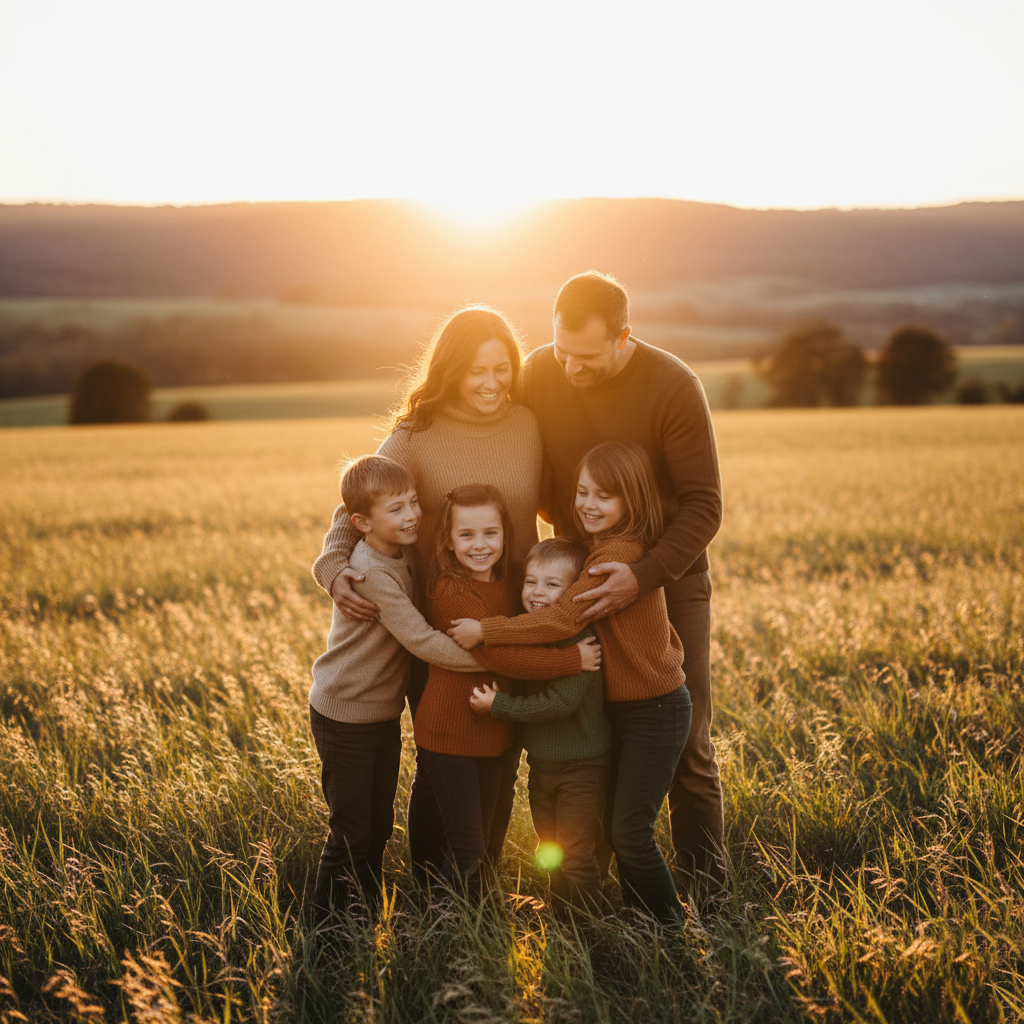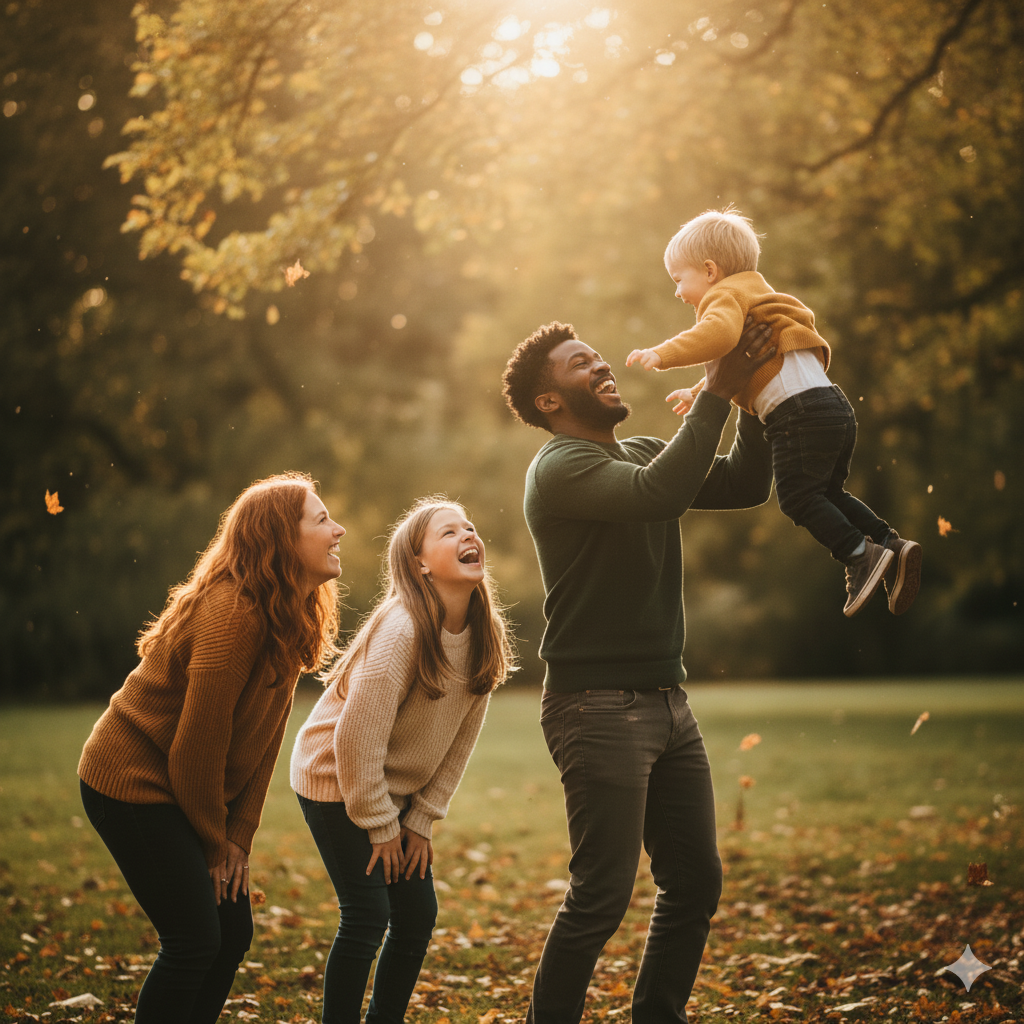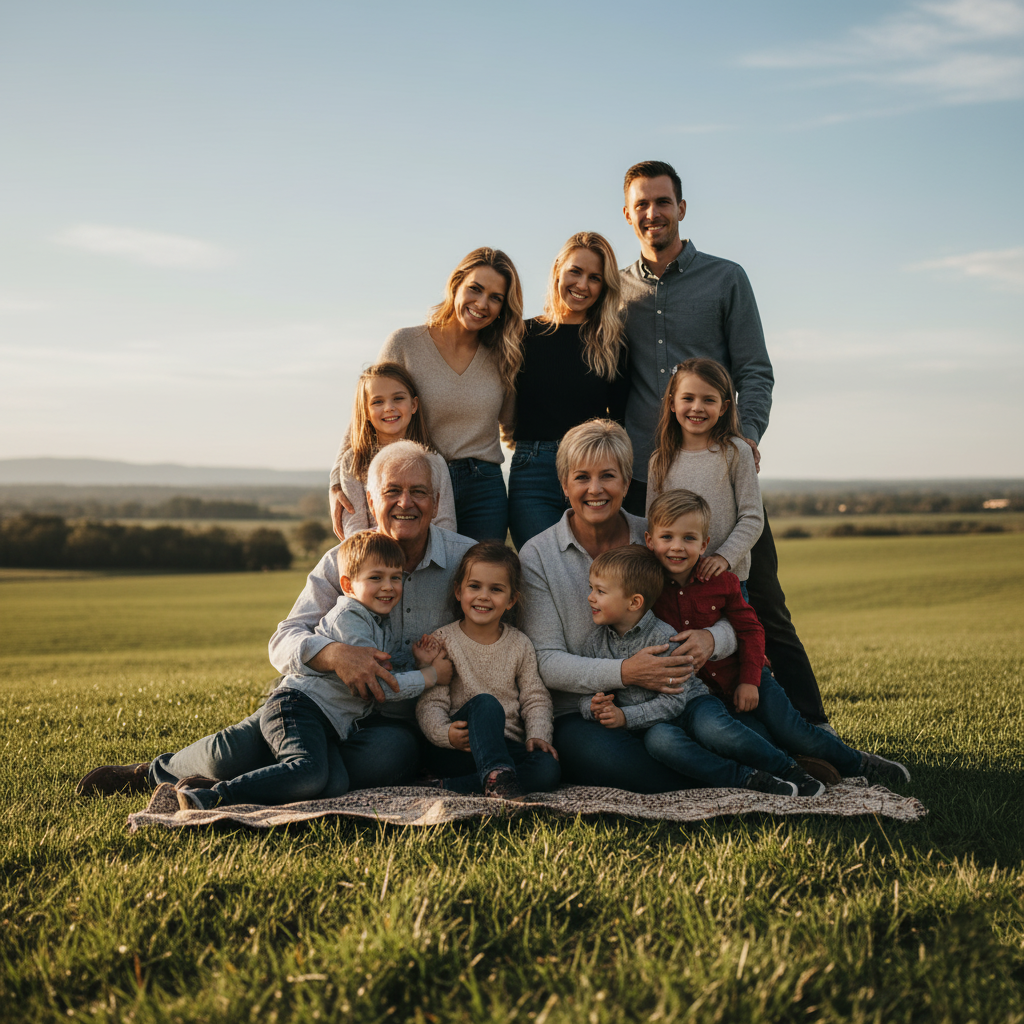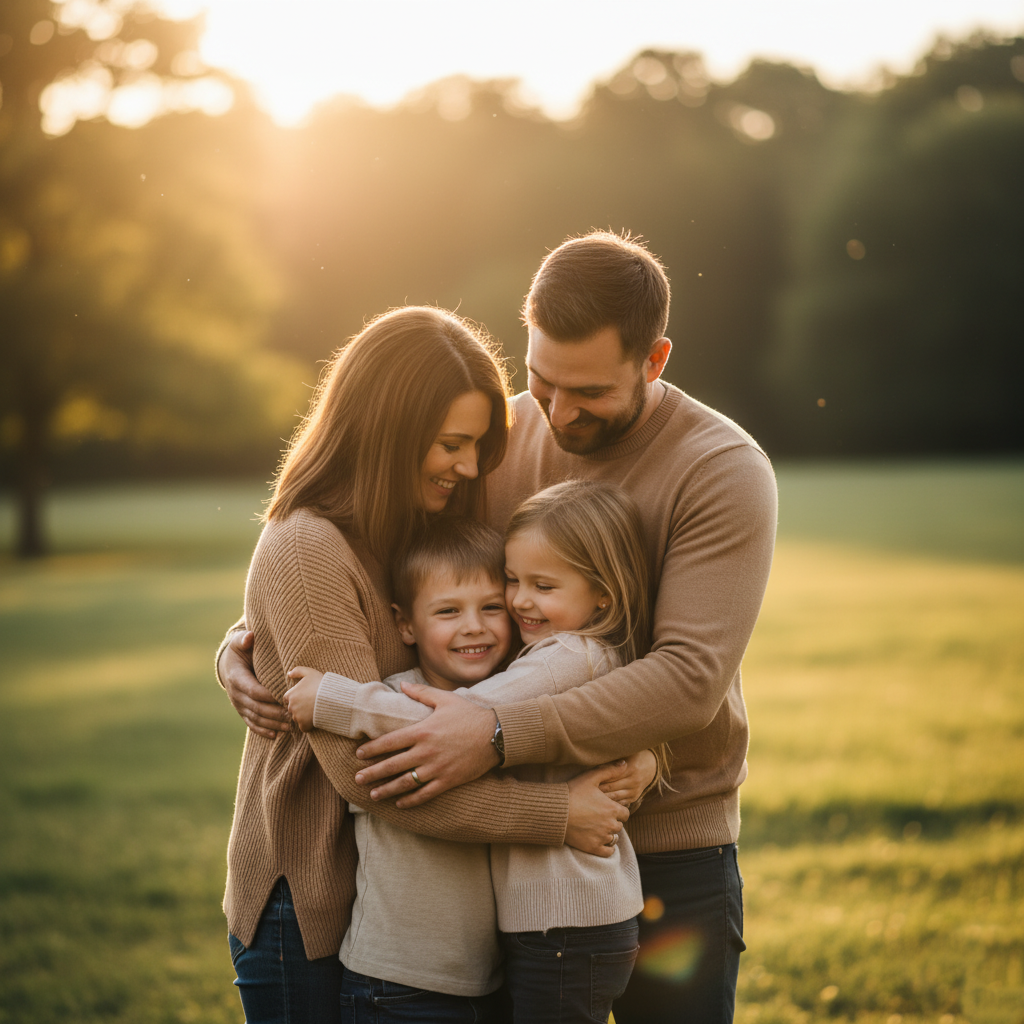Family photos are more than just portraits; they are visual memories that capture the essence of bonds, shared history, and the moments that define a life together. Each family photograph has the power to evoke emotions, recall anecdotes, and strengthen a sense of belonging. However, achieving an image that conveys closeness and authenticity depends not only on a good camera or the right lighting, but also on the pose. Well-chosen family poses don’t strive for perfection, but for connection: natural gestures, knowing glances, and spontaneous smiles that reveal the affection that unites those in front of the lens.
Over time, family photography has evolved, moving from formal and rigid portraits to more dynamic compositions, where movement, interaction, and emotion take center stage. The key is to create images that reflect the family’s identity, whether in an intimate setting like home or outdoors, taking advantage of natural light and the surrounding environment. Each pose can tell a different story: the tenderness of a hug, the joy of a shared game, or the understanding in a glance between parents and children.
In this article, we’ll explore five family photo pose ideas that combine aesthetics, emotion, and authenticity. More than just guiding your posture, they aim to inspire real moments where love and togetherness are effortlessly expressed. Each suggestion is suitable for different types of families and settings, demonstrating that the best photo isn’t always the most perfect, but rather the one that captures a genuine moment of connection.
1.The Group Hug

The family hug is one of the most sincere and touching poses there is. It not only represents love and unity but also conveys warmth and closeness in a natural way. This pose is ideal for breaking the rigidity of formal photos, as it encourages spontaneity and genuine smiles. When arranging it, the goal isn’t to ask everyone to hug perfectly, but rather to invite the family to come closer, laugh, and enjoy the moment. The photographer can capture both the frontal hug, where everyone is looking at the camera, and the moments before or after, when the most genuine expressions emerge.
The key to this pose lies in the connection between bodies and gazes. When arms intertwine and heads rest on one another, body language reflects affection and protection. It’s important for the photographer to capture different angles: from above to show all the faces, or from the side to highlight the tenderness of the gesture. Natural light—especially at dawn or dusk—accentuates the warm and emotional atmosphere that characterizes this type of image. Furthermore, group hugs work for all types of families: large or small, with young children or teenagers, even with pets. The key is that the physical contact isn’t forced, but rather arises from genuine connection. This type of photograph transcends time because it not only documents a family gathering, but also immortalizes the feeling of belonging.
2. The Family Walking

A family walk is one of the most natural and dynamic poses for a photo shoot. It allows you to capture movement, interaction, and joy spontaneously, without anyone having to stay still or pose rigidly. This idea works especially well outdoors—in a park, on a beach, or along a nature trail—where the surroundings become the perfect backdrop to reflect family connection. The magic of this pose lies in its simplicity: walking together, holding hands, or chatting is enough to obtain images full of life and authenticity.
The photographer can position themselves in front of the family or to the side, capturing both the smiles and the rhythm of their steps. If the children run or get ahead, these spontaneous moments add freshness and naturalness to the composition. The light of the sunset or a cloudy morning softens the shadows and gives the scene a warm and even tone. It’s not about achieving a perfectly ordered image, but about finding beauty in shared movement. The laughter, gestures, and glances exchanged between parents and children are the true stars of the show.
This pose also allows you to play with distance: you can take wide shots to showcase the landscape, or zoom in to capture details like intertwined hands or feet moving in sync. More than just a walk, this pose symbolizes the shared journey, the bond built step by step, and the joy of being together.
3. Spontaneous play

One of the best ways to capture the authentic essence of a family is through play. Spontaneous play poses don’t require complicated instructions or fixed positions; it’s about letting the family interact freely and capturing those moments full of laughter, energy, and affection. It could be a round of hugs, a little competition, lifting the children up, or simply running together. This type of photography reveals the personality of each member and the family dynamic in a genuine, joyful, and emotional way.
The key to this pose is naturalness. The photographer acts almost as an invisible observer, ready to capture those seconds when happiness shines through unfiltered. Facial expressions and spontaneous gestures are what transform an ordinary image into an unforgettable memory. The setting also plays a role: a garden, a beach, or an open field provide freedom of movement and a background full of color and texture. Furthermore, natural light highlights the freshness of the moment and prevents the image from looking artificial.
Spontaneous play not only reflects fun but also unity. Shared laughter and knowing glances between parents and children tell a story of love and connection without words. These kinds of photos are perfect for family albums or portraits that aim to convey joy and authenticity. Spontaneity, in this case, is the best pose.
4. In layers or levels

Layered posing, also known as tiered posing, is a visually balanced technique perfect for highlighting family unity within a neat yet natural composition. This idea involves arranging family members at different heights or positions—some seated, others standing, or even crouching—so that everyone blends harmoniously within the frame. Rather than a rigid formation, the intention is to create an image where each person finds their place without losing the connection with the others. This arrangement generates visual depth and allows all faces to be clearly visible, which is essential when there are several family members.
This type of pose works well both outdoors and indoors. In a natural setting, such as a field, a beach, or a garden, the different levels can be created using the terrain or elements like logs, rocks, or stairs. In a domestic setting, a sofa, a large bed, or a rug can serve as the base for a cozy and spontaneous composition. The key lies in the interaction: a hand on the shoulder, a glance between parents and children, or a shared smile can break the rigidity of the pose and fill the image with warmth.
Beyond its aesthetic value, the layered pose symbolizes balance and mutual support. Each level represents the diversity of ages and roles within the family, yet all remain connected, showing how differences unite in a single bond. It’s an ideal pose for formal portraits that aim to maintain a natural feel.
5. The shared look

Among the most emotive and symbolic poses for family portraits is the shared gaze. Unlike traditional photos where everyone looks directly at the camera, this pose invites family members to look at each other. It could be a look from parents to children, from siblings to each other, or even an exchange of smiles among them all. The goal is to capture the group’s emotional connection, that silent complicity that only exists between those who know each other deeply. This pose conveys tenderness, trust, and genuine love, transforming a simple image into a portrait full of meaning.
To achieve this type of photograph, it’s ideal to create a relaxed atmosphere where glances arise naturally. The photographer can suggest that family members move closer, hold hands, or laugh together, so that expressions flow effortlessly. Soft lighting and neutral backgrounds help focus attention on the faces and emotions. When taken outdoors, the warm tones of sunrise or sunset enhance the intimacy of the scene and envelop the image in a nostalgic and serene atmosphere.
A shared gaze doesn’t need perfection, just truth. It’s a pose that reminds us that family photography isn’t about smiling for the camera, but about showing what truly unites people. By freezing a moment of genuine connection, the image acquires emotional value and endures as a symbol of love and belonging.
Conclusion
Family photos are much more than simple portraits; they are time capsules that preserve the essence of those we love and the moments we share. Each of the five ideas presented—the group hug, the walk, the spontaneous play, the layered pose, and the shared gaze—demonstrates that the key to a good photograph lies not in technical perfection, but in authenticity. The best family photos are those that capture real emotions, sincere gestures, and invisible bonds that can be felt even without words.
The secret is creating an environment where everyone feels comfortable, free to be themselves. It’s not about “posing” in the strict sense, but about living in the moment and letting the photographer capture those small expressions that define a family: a shared laugh, an unexpected hug, a look of pride or tenderness. Natural light, the chosen setting, and the emotional state of the participants are the ingredients that, combined, transform a photograph into an eternal memory.
A family photo session doesn’t just document a moment; it celebrates the history and the bond that is built day by day. Over time, these images become visual treasures that remind us who we were, how we grew, and how much love existed in every gesture. In the end, the best poses are those that aren’t entirely planned, but rather those that come from the heart.





